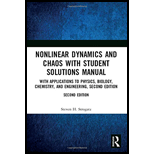
Concept explainers
Interpretation:
All the qualitatively different
Concept Introduction:
The qualitative change in the dynamics of the flow with parameters is called bifurcation and the points at which this occurs is called bifurcation points.
The stability of the dynamical systems can be studied using bifurcation.
Transcritical bifurcation is one of the bifurcation mechanism in which two fixed points exchange their stability instead of destroying.
In the transcritical bifurcation, fixed points exist for all values of the parameter.
Want to see the full answer?
Check out a sample textbook solution
Chapter 3 Solutions
EBK NONLINEAR DYNAMICS AND CHAOS WITH S
- Q2. Government of Canada is designing Registered Retirement Saving Plans (RRSP) for Canadians. According to statistics Canada, the life expectancy in Canada is 86 years with standard deviation of 4.8 years. a) Find the z-score of a person who is 90 years old? b) Find the age of a person whose z-score is -1.4? c) What percent of people age higher than 80? d) What percent of people age less than 83? e) What percent of people age between 85 and 88?arrow_forwardb pleasearrow_forward(b) Let I[y] be a functional of y(x) defined by [[y] = √(x²y' + 2xyy' + 2xy + y²) dr, subject to boundary conditions y(0) = 0, y(1) = 1. State the Euler-Lagrange equation for finding extreme values of I [y] for this prob- lem. Explain why the function y(x) = x is an extremal, and for this function, show that I = 2. Without doing further calculations, give the values of I for the functions y(x) = x² and y(x) = x³.arrow_forward
- Definition: A topology on a set X is a collection T of subsets of X having the following properties. (1) Both the empty set and X itself are elements of T. (2) The union of an arbitrary collection of elements of T is an element of T. (3) The intersection of a finite number of elements of T is an element of T. A set X with a specified topology T is called a topological space. The subsets of X that are members of are called the open sets of the topological space.arrow_forward2) Prove that for all integers n > 1. dn 1 (2n)! 1 = dxn 1 - Ꮖ 4 n! (1-x)+/arrow_forwardDefinition: A topology on a set X is a collection T of subsets of X having the following properties. (1) Both the empty set and X itself are elements of T. (2) The union of an arbitrary collection of elements of T is an element of T. (3) The intersection of a finite number of elements of T is an element of T. A set X with a specified topology T is called a topological space. The subsets of X that are members of are called the open sets of the topological space.arrow_forward
- Definition: A topology on a set X is a collection T of subsets of X having the following properties. (1) Both the empty set and X itself are elements of T. (2) The union of an arbitrary collection of elements of T is an element of T. (3) The intersection of a finite number of elements of T is an element of T. A set X with a specified topology T is called a topological space. The subsets of X that are members of are called the open sets of the topological space.arrow_forward3) Let a1, a2, and a3 be arbitrary real numbers, and define an = 3an 13an-2 + An−3 for all integers n ≥ 4. Prove that an = 1 - - - - - 1 - - (n − 1)(n − 2)a3 − (n − 1)(n − 3)a2 + = (n − 2)(n − 3)aı for all integers n > 1.arrow_forwardDefinition: A topology on a set X is a collection T of subsets of X having the following properties. (1) Both the empty set and X itself are elements of T. (2) The union of an arbitrary collection of elements of T is an element of T. (3) The intersection of a finite number of elements of T is an element of T. A set X with a specified topology T is called a topological space. The subsets of X that are members of are called the open sets of the topological space.arrow_forward
 Elementary Linear Algebra (MindTap Course List)AlgebraISBN:9781305658004Author:Ron LarsonPublisher:Cengage Learning
Elementary Linear Algebra (MindTap Course List)AlgebraISBN:9781305658004Author:Ron LarsonPublisher:Cengage Learning
